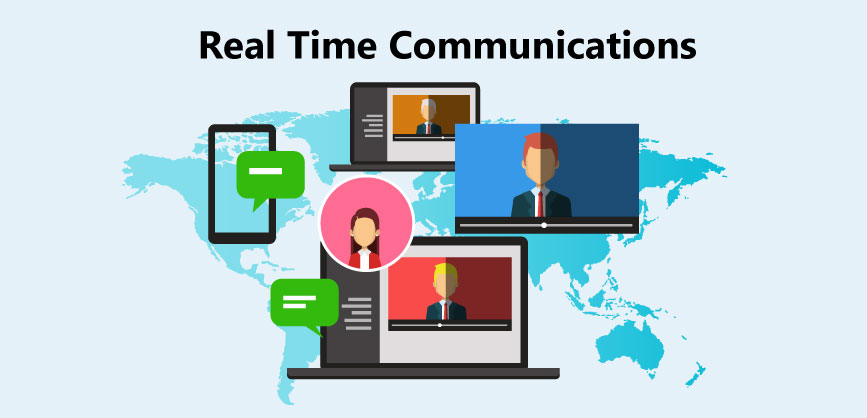
Here are examples of real time communications :
- VoIP.
- Robotic telepresence.
- Video and teleconferencing.
- Instant messaging like WhatsApp.
- Voice over mobile phones and landlines
But, blogs, bulletin boards, email, and other means of internet communication are not real-time communications. In short, any method of internet communication that involves the users to read content, without taking the time it was posted into consideration, is not real-time communication.
Furthermore, real-time communication are instant. There is no storage in the intermediate state. Therefore, it is true to say that real-time communications are also live communications.
This kind of communication has a return path that the receiver uses to communicate with the sender in actual time. And, real-time communications can occur in either full-duplex or half-duplex.
- Full duplex : The sender and the receiver may send and receive messages at the same time in two parallel communication directions.
- Half duplex : Communication in one direction and through channel occurs one at a time. Here, the sender or receiver may send but receive at a different time. For example, in a walkie-talkie, the user must say “over” to authorize the person on the other end to speak.
Why is Real Time Communication Essential?
Following the widespread use of smartphones, business customers and consumers expect instant information exchange and customer service. This makes this communications valuable. For instance, if a passenger misses a connecting flight, he or she can contact the reservations center through the airline’s app, if stranded at the interceding centre.
As a result, the customer gets ideal service if the reservations hub knows the problem of the passenger at the precise time of chat or call. The agents must have received updates of that flight. So, the passenger does not need to explain the situation again. This saves the resolution time and enhances the customer experience.
Real Time Communication for Business
Although real-time communications might appear new to consumers, most businesses have been using this functionality for a long time. For example, cloud communications messaging apps like Slack, Skype, and HipChat have been using real-time communications from the start.
Today, real-time communications apps use voice communications more often, thus avoiding traditional telephony providers. For real-time ride-hailing app in Southeast Asia bypasses the undependable local carrier infrastructure for direct communication with customers via voice messages that get delivered through Voice API. Indeed, businesses and their workers can save their money and time, by communicating in a unified communications app that has improved abilities.

In addition, real-time communications use cases in business have grown into other commercial industries. For instance, in retail stores and restaurants where the employee’s job description involves standing moving all the time, they are using real-time communications for work news, employee planning, coordination, and others.
Without a doubt, real-time messaging on an app may substitute blanket emails to employees on internal announcements. This enhances engagement and answering questions from employees in a manner that an email cannot do. This type of real-time communication can greatly benefit employees who work in shifts for groups like waiters, landscapers, nurses, and emergency responders.
The Future of Real Time Communication
It is predicted that there will be over 20.8 billion connected devices like routers, remote sensors, PCs, tablets, and phones by 2020. So, the internet of everything must be a real-time communications network.
Actually, a bit of this future is now seen in disruption and utility in the Uber car-sharing app. The driver is ready to hire whenever a customer needs a ride. Although a simpler transaction relationship of transport existed for years, the technology revolution led to the start of real-time communications on the back-end systems.
Moreover, the communications platforms and APIs as a service have facilitated the online consumption model. This is through the connection of humans, machines, and devices for a huge exchange of ideas, information, and data. In this model, the APIs acting as a type of digital currency. Also, companies can integrate real-time communications straight in their business processes and apps, to leverage them for productive, dependable, and safe transactions.
In addition, it is predicted that attaching messaging, video, and voice through APIs, this communications will make the creation of solution easier. Also, the service connection in business processes, websites, and mobile apps will be easier. And, real-time communications will support outperformance and underpricing of traditional communication solutions.
Conclusion
In the present world, the number of smartphone users has continued to grow daily. And, most users prefer using communication app to connect with their family and friends. This had made most businesses to introduce real-time communications in their services for ease of doing business. Indeed, most enterprises consider instant and safe communications a basic need for their daily activities. So, the importance of real-time communication grows daily.
You can make Communication simple & secure with HD Voice calling.
If you have any questions, suggestions, or comments on real-time communications, use our comments section.
